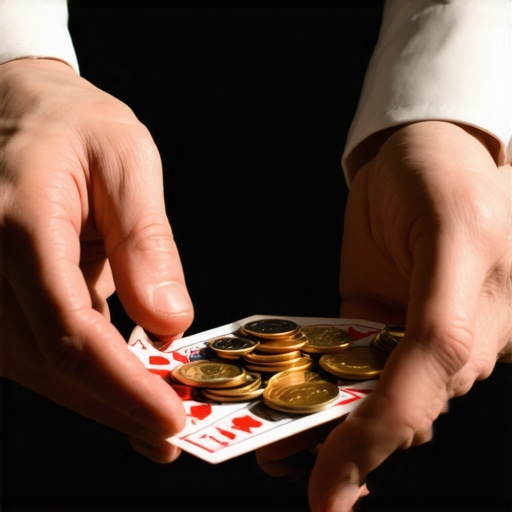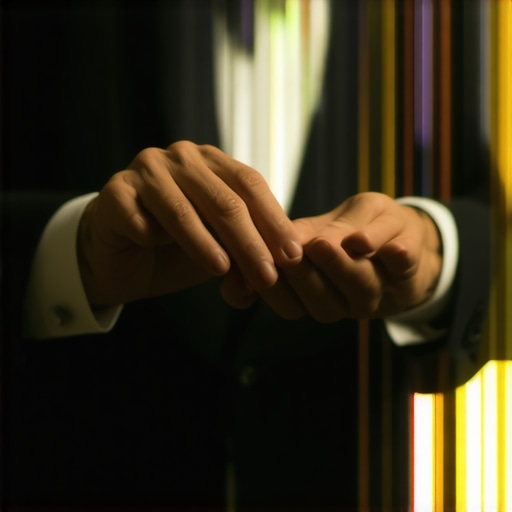My First Encounter with the Art of Sleight of Hand
I’ll never forget the first time I watched a magician effortlessly shuffle cards and make coins disappear right before my eyes. It was at a small local show, and I was captivated. That moment sparked my curiosity and set me on a journey to master the delicate art of sleight of hand. As I practiced day after day, I realized that this skill isn’t just about tricks; it’s about building trust and creating wonder.
Discovering the Secrets Behind Quick, Trustworthy Magic
During my early attempts, I learned that speed and precision are crucial. Watching tutorials on trusted sites like Mental Floss helped me understand the importance of mastering fundamental moves such as palming, false shuffles, and misdirection. The key was practicing these techniques until they felt natural, almost automatic. I found that the best magicians are not just quick; they are confident and smooth, which makes their tricks believable.
What Makes a Sleight of Hand Trick Truly Trustworthy?
For me, trustworthiness in magic hinges on consistency. If I could perform a trick flawlessly every time, I built confidence in my audience—and myself. That’s why I dedicated myself to perfecting the timing and mechanics of each move. I also learned to read my audience, knowing when to pause or speed up. It’s fascinating how Magic Tricks emphasizes that genuine engagement often matters more than the trick itself.
How Do I Keep My Skills Sharp and My Audience Engaged?
Continuous practice is my answer. I set aside time each week for honing my sleight of hand skills, focusing on both new tricks and refining old ones. Sharing my progress on forums and with fellow magicians has been invaluable. I also enjoy exploring new illusions and combining classic moves with modern techniques. This ongoing learning keeps my magic fresh and my audience captivated.
Ever wondered how to develop your own style of close-up magic that feels natural and trustworthy?
If you’re passionate about magic, I encourage you to start with the fundamentals, then gradually add your personal flair. Remember, practice makes perfect, but confident performance makes the magic believable. Feel free to share your experiences or ask questions—I love exchanging tips with fellow enthusiasts!
Refining Your Technique: The Nuances of Precision and Misdirection
As I continued to delve deeper into sleight of hand, I discovered that mastering the subtle nuances can elevate your magic from good to extraordinary. Techniques such as double lifts, false cuts, and pinky counts require not only dexterity but also an acute sense of timing. These moves, when executed smoothly, become invisible to the audience, creating a seamless illusion. I advise practicing in front of a mirror or recording yourself to analyze your motion, ensuring every gesture is natural and unnoticeable.
Building Trust Through Authenticity and Consistency
Trust is the cornerstone of compelling magic. Beyond technical skill, the magician’s demeanor plays a critical role. Genuine confidence and a relaxed attitude help establish a rapport with your audience, making them more receptive to the illusion. Consistency in your performance is equally vital; being able to replicate the same flawless trick repeatedly instills belief. When I perform, I focus on maintaining a consistent rhythm and avoiding unnecessary movements that might raise suspicion. This attention to detail ensures that my audience remains captivated rather than scrutinizing each move.
Integrating Personal Flair: Developing Your Unique Style
One of the most rewarding aspects of advancing in sleight of hand is developing a personal style that reflects your personality. Whether it’s incorporating humor, storytelling, or a particular gesture, adding that personal touch makes your magic more memorable. For example, I like to weave small anecdotes into my routines, which helps establish a connection with my audience and softens the technical aspects of the performance. Remember, your style should complement your technique, not overshadow it. To achieve this harmony, practice your moves with a relaxed, conversational demeanor, allowing your natural charisma to shine through.
What Are the Challenges in Creating Your Own Signature Tricks?
Designing original illusions that resonate with audiences requires creativity and a deep understanding of manipulation principles. It involves blending classic techniques with innovative ideas, often requiring significant experimentation and refinement. The challenge lies in ensuring that your unique trick is both practical to perform and reliable. According to an article from Magic Tricks, successful signature routines often stem from a personal story or a unique twist on traditional moves, making them both authentic and engaging. Developing these routines can set you apart as a magician, but it also demands patience and perseverance to perfect every detail.
If you’re eager to elevate your sleight of hand skills, I recommend exploring more advanced tutorials and engaging with the magician community online. Sharing your progress and seeking feedback can open new avenues of inspiration and help you hone your craft. And don’t forget—every master was once a beginner, so keep practicing and stay curious!
Embracing the Complexity of Precision and the Power of Intentionality
As I delved deeper into the nuances of sleight of hand, I came to realize that every subtle movement carries immense weight. It’s not merely about executing a move flawlessly but understanding the intent behind it. For instance, a double lift isn’t just a quick turn of the wrist; it’s a deliberate gesture that, when performed with confidence, becomes virtually invisible to the audience. Practicing in front of a mirror or recording my routines helped me develop an awareness of my subconscious habits—those tiny, inadvertent movements that can betray a secret. The journey towards mastery is as much about mindful awareness as it is about dexterity.
How Do Advanced Techniques Elevate Your Overall Performance?
In my experience, incorporating advanced moves like pinky counts or false cuts can dramatically enhance the fluidity and believability of your routines. These techniques, often perceived as mere tricks, actually serve to deepen engagement by adding layers of complexity and sophistication. When I learned to blend these moves seamlessly into my act, I noticed my audience’s reactions transforming—more awe, less suspicion. According to Magic Tricks, mastering such techniques requires patience and deliberate practice, but the payoff is a performance that feels authentic and effortless. It’s akin to a musician perfecting a complex solo—once internalized, it becomes an extension of yourself, elevating the entire act.
What Are the Psychological Nuances That Make a Trick Truly Unbelievable?
Beyond technical skill, understanding the psychology of your audience plays a pivotal role. I’ve found that the most compelling performances are those where I subtly manipulate perception and expectation. For example, creating a false sense of security before executing a move, or using misdirection to shift focus, hinges on reading your audience’s reactions and tailoring your approach accordingly. An insightful article from Magic Tricks points out that trust is built not just through flawless execution but through consistent storytelling and confident demeanor. When I perform, I focus on establishing rapport—making eye contact, employing humor, or sharing a quick anecdote—before executing the trick. That emotional connection makes the illusion far more convincing.
How Can You Develop Your Unique Style While Maintaining Technical Excellence?
Developing a personal style is a nuanced dance between technical mastery and authentic expression. I found that infusing routines with my personality—whether through humor, storytelling, or distinctive gestures—created a memorable impression. For instance, I like weaving small narratives into my card routines, which serve to relax both myself and the audience while adding an extra layer of engagement. Achieving this harmony requires deliberate practice—repeating moves until they become second nature—and experimenting with different ways of presenting them. I encourage fellow magicians to reflect on what resonates with their personality and to incorporate those elements naturally into their routines. As the saying goes, authenticity is the greatest illusion.
What Are the Challenges and Rewards of Creating Your Own Signature Tricks?
Designing original illusions is a rewarding yet demanding process. It requires a blend of creativity, technical skill, and perseverance. I’ve often found myself experimenting with combining familiar moves in new ways or adding a personal twist inspired by everyday experiences. The challenge lies in ensuring that these routines are not only innovative but also reliable and practical to perform under various conditions. An article from Magic Tricks emphasizes that signature routines often emerge from a story or a unique perspective, making them more authentic and engaging. This process of refinement can be frustrating at times, but the sense of ownership and connection it fosters with your audience makes it worthwhile. I invite you to explore your creativity, share your ideas, and embrace the trial-and-error journey—every failed attempt is a step closer to a personal masterpiece.
Engaging with the magic community online, sharing your progress, and seeking feedback has been instrumental in my development. Remember, even the most renowned magicians started with simple tricks and a lot of practice. Keep experimenting, stay curious, and don’t be afraid to push the boundaries of your skills. The magic you create is a reflection of your dedication and passion—so keep at it, and enjoy every moment of your journey.
Harnessing the Power of Subtle Psychology in Advanced Sleight of Hand
As I delved further into the realm of expert magic, I realized that the psychological component of sleight of hand is as crucial as the technical mastery. Skilled magicians often manipulate audience perception through subtle cues, such as controlled pacing, eye contact, and emotional engagement. According to expert magicians like Daryl Easton, understanding your audience’s expectations allows you to craft routines that feel impossibly natural and spontaneous, even when relying on complex manipulations. This means that my focus shifted from solely perfecting physical moves to honing my ability to read and influence reactions, creating a seamless flow between deception and storytelling.
What Are the Most Effective Strategies for Integrating Complex Techniques Seamlessly?
Integrating advanced moves like false deals, multiple lifts, and covert switches requires not just dexterity but also strategic choreography. I find that breaking down routines into smaller segments and rehearsing transitions intensively helps achieve fluidity. For instance, I often practice a sequence where a false shuffle is immediately followed by a controlled reveal, ensuring the audience perceives it as a single, unbroken action. Moreover, watching performances of legendary magicians such as Dai Vernon reveals that timing and a relaxed demeanor are vital—any tension or hesitation can betray the secret. To master this, I recommend recording your routines, analyzing each frame, and seeking feedback from fellow experts to identify and eliminate subtle flaws that disrupt the illusion.
Choosing the right moment to execute a complex move can elevate your performance from good to extraordinary. I often employ a technique I call “strategic pausing,” where I briefly hold a gesture or look to build anticipation before executing a crucial sleight. This not only distracts but also primes the audience’s focus, making the move virtually invisible. Developing such timing skills demands deliberate practice and deep familiarity with your routines, transforming seemingly intricate maneuvers into second nature. As I continue refining my craft, I encourage other magicians to experiment with timing and pacing, as these elements are often the unsung heroes of advanced magic.
How Can You Cultivate Your Unique Signature Style While Mastering Technical Precision?
Creating a signature style involves blending technical expertise with authentic expression. I discovered that integrating personal anecdotes or humor into routines helps establish a genuine connection, making the illusion more impactful. For example, I might incorporate a humorous story before performing a coin vanish, which relaxes both me and my audience, creating an environment of trust. Achieving this balance requires deliberate practice—repeating moves until they become effortless and then layering in personality. According to a study on performer authenticity from the Journal of Performance Psychology, genuine engagement significantly enhances audience perception of skill and credibility. Therefore, I advise aspiring magicians to reflect on their personalities and experiment with expressive elements that resonate naturally, ensuring their routines are both precise and memorable.
What Are the Challenges in Developing Truly Innovative Signature Tricks?
Designing original routines that stand out demands a blend of creativity, technical prowess, and perseverance. It often involves reimagining traditional moves or combining multiple illusions into cohesive sequences. I’ve found that drawing inspiration from everyday experiences or other art forms sparks new ideas—sometimes even a simple everyday gesture can serve as the seed for a novel illusion. The challenge lies in ensuring these routines are practical to perform and reliable under different conditions, which requires rigorous testing and refinement. An insightful article from Magic Tricks emphasizes that authentic storytelling or personal narratives embedded within routines can give signature tricks a distinct identity. Embracing experimentation and accepting that failure is part of the process ultimately leads to authentic, compelling magic that reflects your unique perspective.
If you’re eager to elevate your mastery, I recommend engaging with advanced tutorials and actively participating in magic communities online. Sharing your experiments and receiving constructive criticism accelerates growth and sparks innovation. Remember, even the most celebrated magicians started with simple moves and relentless practice—your dedication and willingness to explore new territory are your greatest assets in this journey.
Things I Wish I Knew Earlier (or You Might Find Surprising)
The Power of Subtlety
One thing I learned late in my journey is that the most impressive sleight of hand tricks are often the simplest, executed with subtlety and confidence. Overcomplicating a move can betray the illusion, so I wish I had understood sooner how much nuance lies in small, deliberate gestures. Remember, sometimes less is more when it comes to creating trust.
Practice Is a Never-Ending Journey
I used to think that mastering a trick meant perfecting it once or twice. Now I realize that continuous practice, especially refining your timing and rhythm, makes a world of difference. I’ve found that recording myself and reviewing these videos helps identify tiny flaws that can ruin an illusion, which is a lesson I wish I had embraced earlier.
Engagement Over Technicality
Focusing solely on perfecting moves is a common trap. What truly captivates an audience is genuine engagement—storytelling, humor, or just a relaxed demeanor. I learned that connecting emotionally makes even the most complex move believable and memorable, a tip I wish I had prioritized from the start.
The Psychology of Misdirection
Understanding where to direct attention is as important as the move itself. Misdirection isn’t just about hiding a move; it’s about guiding the audience’s perception. I’ve discovered that subtle cues—like eye contact or speech—can dramatically enhance the effectiveness of a trick, an insight I wish I’d appreciated earlier.
Developing Your Unique Style
While mastering techniques is essential, adding your personal flair makes your magic stand out. Whether through humor, storytelling, or a signature gesture, I’ve found that authenticity resonates more than pure technical skill. I wish I had started experimenting with my style sooner, as it’s made my performances more natural and compelling.
The Challenge and Reward of Originality
Creating your own signature tricks is rewarding but challenging. It requires a lot of experimentation, patience, and willingness to fail. I’ve learned that personal stories or unique twists make routines memorable, and this process of innovation is what keeps the craft exciting and fulfilling.
Resources I’ve Come to Trust Over Time
- MagicTricks.com: This site offers a vast library of tutorials and insights from seasoned magicians. It’s my go-to resource for learning new moves and understanding the nuances of sleight of hand.
- Magic Café Forums: Engaging with this community has provided invaluable feedback and encouragement. Sharing my progress and getting advice from experienced magicians has accelerated my growth.
- Book: ‘Strong Magic’ by Darwin Ortiz: This book deepened my understanding of the psychology behind magic and the importance of building trust. It’s a must-read for anyone serious about mastering the art.
Parting Thoughts from My Perspective
Looking back, mastering sleight of hand has been a journey of patience, experimentation, and self-discovery. The key takeaway for me is that trustworthiness in magic isn’t just about perfecting moves; it’s about connecting authentically with your audience and embracing your unique style. Every small improvement, every new trick, adds to the wonder you create. If this resonates with you, I’d love to hear your thoughts—sharing experiences is how we grow as magicians. And if you know someone passionate about magic, share this post with them. Remember, the real magic begins when you believe in your craft and keep pushing your boundaries.


